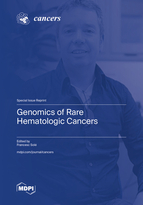Genomics of Rare Hematologic Cancers
A special issue of Cancers (ISSN 2072-6694).
Deadline for manuscript submissions: closed (15 June 2022) | Viewed by 45577
Special Issue Editor
2. Microarrays Unit, Institut de Recerca Contra la Leucèmia Josep Carreras, ICO-Hospital Germans Trias i Pujol, Universitat Autònoma de Barcelona, 08916 Badalona, Spain
Interests: MDS; MDS/MPN; SNP arrays; cytogenetics; NGS; myeloid neoplasms
Special Issue Information
Dear Colleagues,
Leukemias and hematologic cancers occur with less frequency than solid tumors. The most frequent and well-known hematologic cancers could be summarized in chronic and acute myeloid and lymphoid leukemias, myelomas and lymphomas, as well as myelodysplastic syndromes and myeloproliferative neoplasms. In this Special Issue we selected some of the rarest types of hematologic cancers because there are few reviews about these diseases. Now, genomics defines the diagnosis, prognosis, and treatment of most cancers, and we want to present a review of how genomics is useful to define these rare diseases. In this Special Issue we will highlight the genomic information that will be very useful for clinicians to diagnose and treat these patients.
Dr. Francesc Solé
Guest Editor
Manuscript Submission Information
Manuscripts should be submitted online at www.mdpi.com by registering and logging in to this website. Once you are registered, click here to go to the submission form. Manuscripts can be submitted until the deadline. All submissions that pass pre-check are peer-reviewed. Accepted papers will be published continuously in the journal (as soon as accepted) and will be listed together on the special issue website. Research articles, review articles as well as short communications are invited. For planned papers, a title and short abstract (about 100 words) can be sent to the Editorial Office for announcement on this website.
Submitted manuscripts should not have been published previously, nor be under consideration for publication elsewhere (except conference proceedings papers). All manuscripts are thoroughly refereed through a single-blind peer-review process. A guide for authors and other relevant information for submission of manuscripts is available on the Instructions for Authors page. Cancers is an international peer-reviewed open access semimonthly journal published by MDPI.
Please visit the Instructions for Authors page before submitting a manuscript. The Article Processing Charge (APC) for publication in this open access journal is 2900 CHF (Swiss Francs). Submitted papers should be well formatted and use good English. Authors may use MDPI's English editing service prior to publication or during author revisions.
Keywords
- Germline Gene Variants in Myeloid Neoplasms
- chronic eosinophilic leukemia
- GATA2
- hairy cell leukemia
- juvenile myelomonocytic leukemia
- MALT
- mastocytosis
- plasma cell leukemia
- splenic marginal cell lymphoma
- T cell acute lymphoblastic leukemia







